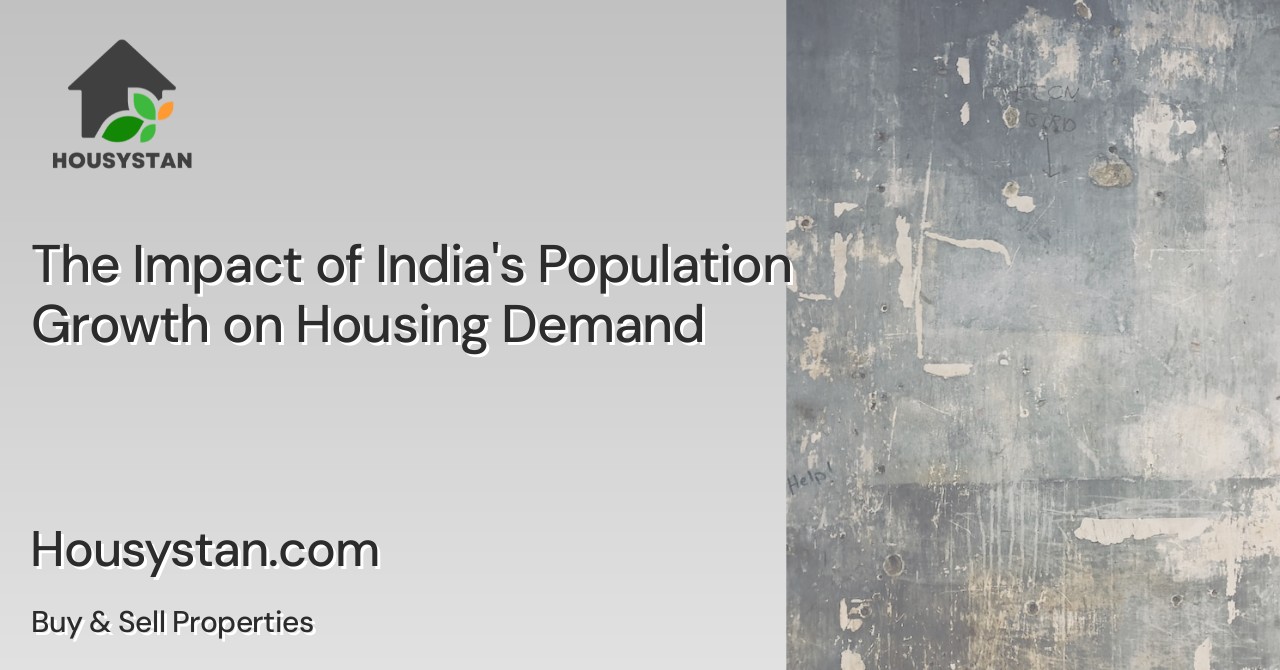The Impact of India's Population Growth on Housing Demand
Read latest blogs and articles from Housystan

The Information mentioned here was last updated on:
2/12/2025The Impact of India's Population Growth on Housing Demand
These days, the spotlight is on India’s population growth and its profound impact on housing demand. As one of the most densely populated countries in the world, India faces unique challenges and opportunities in providing affordable and sustainable housing for its people.
The Explosion of India's Population
- Verified Tenants/Buyers
- Unlimited Property Listing
- Zero subscription/charges fee
India's population growth has been nothing short of remarkable. As of 2023, India has surpassed China to become the world's most populous country, with over 1.4 billion residents. Several factors contribute to this rapid population growth:
- High Birth Rates: Although birth rates have been declining, India still sees a significant number of births annually.
- Improved Healthcare: Advances in medical care have increased life expectancy, contributing to a steadily growing population.
- Youthful Demographics: With a median age of around 28 years, India has a large, youthful population that continues to grow.
Housing Demand: A Looming Challenge
The surge in population translates directly to increased housing demand. The housing sector in India faces the challenge of providing homes for new families while accommodating rural-to-urban migration. Urban areas, in particular, are under significant pressure.
Key Factors Driving Housing Demand
1. Urbanization: Rapid urbanization is leading to population concentration in cities, intensifying the demand for housing.
2. Economic Growth: As India’s economy expands, more individuals can afford better housing, elevating overall demand.
3. Migration Trends: People moving from rural to urban areas in search of better job opportunities exacerbate housing pressures in cities.
Urban Housing: The Epicenter of Demand
Cities like Mumbai, Delhi, and Bangalore are central to India's housing crisis. Rapid urbanization brings about distinct challenges:
- Limited Land Availability: Urban areas have limited land for new developments, leading to escalating property prices.
- Slums and Informal Settlements: Lack of affordable housing has led many urban poor to inhabit slums, lacking basic amenities.
- Infrastructure Strain: Existing urban infrastructure struggles to keep pace with the burgeoning population, leading to issues such as traffic congestion and inadequate sanitation.
Affordable Housing: A Solution and a Challenge
The term "affordable housing" often evokes visions of government projects and sprawling townships on city outskirts. However, achieving truly affordable housing is a complex issue.
Government Initiatives
The Indian government has made significant strides to address housing demands through initiatives like:
- Pradhan Mantri Awas Yojana (PMAY): Launched in 2015, this scheme aims to provide affordable housing to all by 2022, targeting economically weaker sections (EWS) and low-income groups.
- Smart Cities Mission: This program is designed to drive economic growth and improve quality of life by enabling local development and leveraging technology.
Private Sector Innovations
The private sector also contributes to alleviating housing pressures by exploring innovative construction methods and financing models:
- Pre-fabricated Construction: Using pre-fabricated materials can reduce construction time and costs, making housing more affordable.
- Public-Private Partnerships: Collaborations between government and private entities are being used to develop affordable housing projects.
Sustainability and Eco-friendly Housing
Sustainability in housing is becoming increasingly important as the environmental impact of construction grows. Green housing initiatives focus on:
- Energy Efficiency: Incorporate sustainable building materials and renewable energy sources.
- Water Management: Use modern plumbing fixtures and rainwater harvesting systems.
- Waste Management: Implement effective waste segregation and recycling systems.
The Role of Technology
Technology is shaping the future of housing in India in various ways:
- Digital Real Estate Platforms: Simplify the buying, selling, and renting processes, making the housing market more accessible.
- Smart Home Solutions: Homes equipped with smart technology offer modern conveniences and enhance energy efficiency.
- Remote Work Trends: The rise of telecommuting is prompting shifts in housing preferences, with more people seeking homes with office spaces.
The Future of Housing in India
The future of India's housing market depends on several variables, including economic policies, technological advancements, and population trends. The ongoing effort to meet housing demand will likely focus on several strategic areas:
- Expansion of Tier-2 and Tier-3 Cities: Development in smaller cities will reduce pressure on major urban centers by redistributing the population.
- Innovative Financing Options: Providing accessible housing finance to a broader section of the population will be vital.
- Emphasis on Mixed-use Developments: Integrating residential, commercial, and recreational spaces reduces the need for long commutes, enhancing quality of life.
Housing demand in India, driven by its rapidly growing population, poses both a challenge and an opportunity. By focusing on sustainable development, leveraging technology, and ensuring continued government and private sector collaboration, India can strive to meet its housing needs effectively while nurturing its economic growth.
This ever-evolving landscape means that the conversation around housing in India will continue, with new challenges and solutions emerging over time. Explore our [India Housing Market Insights]() for more in-depth analysis and reports on current trends.